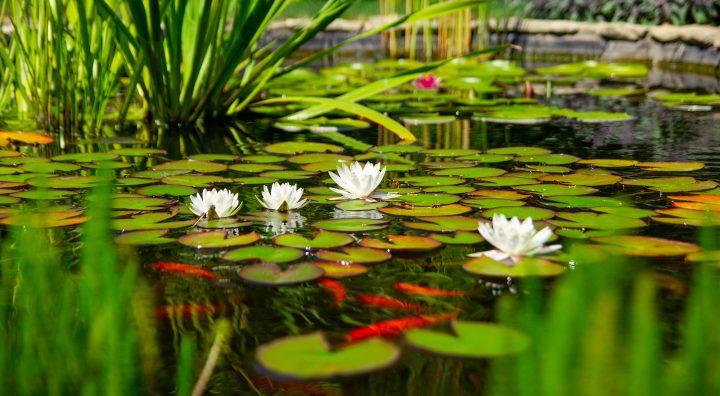
If you want your pond to become a mini-ecosystem, especially if you plan on adding fish or you want to attract frogs and other creatures, then you will need to add plants.
Think of pond plants and most people immediately think of the two conspicuous water plants – the beautiful water lilies and the floating ‘weeds’ – but there is a lot more to pond plants than just these groups.
The main reason you’ll likely think of for adding plants is their aesthetic benefits, in-short, they look great. If you’re a gardener you’ll also find it fun to move your gardening experience into a new watery realm. Reality is they have a host of benefits beyond just appearances and design.
- They expand the diversity of your pond’s ecosystem.
- Will work to keep water clean and healthy by consuming waste and nutrients that may otherwise contaminate or cloud water and lead to algae outbreaks.
- Provide habitat for fish, frogs and other creatures.
- The shade they create helps to keep water temperatures more stable, creates a better environment for fish and also reduces algae risks.
It’s worth developing an understanding of the main groups of pond plants. The plants are generally described by the zone they prefer to live in and there are five zones. You can think of these zones as progressing from surface to the depths.
Zone 1
The floating plants. These are the true free-floaters that have no attachment to the pond bed or walls. The two most commonly seen would be duck weed and azolla. Most pond specialists will recommend avoiding the floating plants. Most will multiply very quickly, covering the surface and cutting off sunlight. Many are in-fact classified as weeds due to their rapid growth and ability to spread.
Zone 2
Are variously described as the bog or waterside plants as they are not in the water. Most are not actually true water plants however they’ll happily live in constantly damp soil beside a pond. Many of these plants add fantastic foliage form to your pond. They include many of the iris, such as the Louisiana, sweet flags such as variegated Acorus, rushes and other plants that don’t mind wet feet.
Zone 3
Called marginal plants they grow in the shallow water up to around 15cm in depth. You’ll often hear many described as emergents as they are living in the water but virtually all growth and flowering is above water. You’ll find lots of lovely iris and some rushes and grasses as well as semi-submerged plants like milfoil which have growth both above and below the surface.
Zone 4
Shallow water plants or sometimes called deep marginals. These plants prefer the slightly deeper and cooler water from 15 to around 40cm. Like the Zone 3 plants most of what they do is above water but they like to have their roots at depth. Here is where you start to add the water lilies, plants like Pontederia and the larger sedges, rushes and reeds.
Zone 5
The deep-water plants. Some are completely submerged others will partially emerge but the common factor is that they like cool, well-shaded roots. The most well-known of these are the larger water lilies and the beautiful lotus.
Although your local garden centre may carry a selection of water plants seasonally you’ll likely find the best source is a specialist supplier many of whom will do mail-order. Before you select plants make sure you do your research as there are many aquatic plants that are recognised as weeds or can go quite weedy and take over your pond.
When installing a new water feature, you want it to provide countless hours of serene, relaxing atmosphere to enjoy. To maximise that enjoyment, and limit maintenance, the perfect pond pump is essential to deliver that peace of mind.
